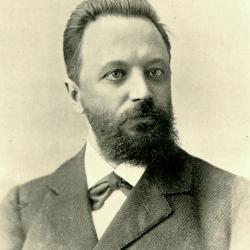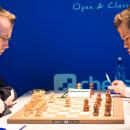Mikhail Chigorin

Bio
Mikhail Chigorin was a Russian master and a world-class player. He tied for first place in the 1889 New York tournament and won the first three All-Russian tournaments from 1899-1903. Chigorin is considered the forefather of the Soviet school and played the first official world champion Wilhelm Steinitz for the title on two separate occasions.
- Style
- Early Chess Career To World Class Player
- World Championship Matches
- Life After The World Championship Matches
- Legacy
Style
Chigorin's style was tactical, aggressive and imaginative. Like most players from the 1860s through the 1890s, he played in a romantic fashion with many sacrifices and ferocious attacks. He was known to play unique openings (like the Evans gambit and his famous 1.e4 e6 2.Qe2 system). In this example, Chigorin uses his own off-beat system versus the French defense against Siegbert Tarrasch (a world-class player at the time). This game from the late 19th century sees a system very close to what we now know as the King's Indian Attack,and ends in a nice tactical combination:
Early Chess Career To World Class Player
Chigorin did not learn to play chess until the age of 16 and did not take the game seriously until he was 24. After finishing his education and starting a career as a government officer, he quit his job in order to pursue chess full-time. In the late 1870s he started a chess magazine and began playing matches against established Russian masters.
After defeating the strong Russian master Semyon Alapin in 1880, he was quickly recognized as one of the strongest players in the country. Here is an early example of Chigorin's aggressive play, where he sacrifices his queen very early for a memorable mating net created with the bishop pair and a rook:
In 1881, Chigorin had his international debut in Berlin. He came in third place (tied with Szymon Winawer) behind world-class players Johannes Zukertort and Joseph Blackburne, but ahead of many masters. In the historic London tournament of 1883, he finished in fourth place (behind Zukertort, Wilhelm Steinitz, and Blackburne) ahead of many world-class players.
It was after this tournament that he was recognized as a world-class player. In 1889, Chigorin tied for first (with Max Weiss) in the strong New York tournament. His performance in this 1889 tournament allowed him to challenge World Champion Steinitz to a match for the title.
World Championship Matches
Chigorin and Steinitz played their first world championship match in 1889. This was also the first time that the first official world champion, Steinitz, would defend his title. Chigorin played well but ultimately lost the match by a score of 10.5-6.5. Three years later, Chigorin and Steinitz played again for the title. The 1892 rematch had many memorable games, and the match was closer than the first. When it was over, Steinitz had defeated Chigorin by a more narrow margin of 12.5-10.5.

In Chigorin's brilliant round-one win in the 1892 world championship match, he employs his beloved Evans gambit and gets great compensation for the gambit pawn. He establishes an octopus knight on d6 before sacrificing it for a powerful attack that keeps Steinitz's king on the sixth rank for the remainder of the game:
Life After The World Championship Matches
Chigorin would never play for the world championship title again after his loss to Steinitz in 1892, but he did not give up on chess at all. By the end of his career, Chigorin had an extremely close lifetime score against Steinitz (24 wins, 27 losses, eight draws). Here is a nice win from Chigorin from this period, where he dominates the dark squares on the kingside before ending the game by controlling the entire first rank:
In 1893, he drew a match with Siegbert Tarrasch, who was also considered a top-five player. In 1895, Chigorin had arguably the best result of his career in the historic Hastings tournament. He came in second place (behind Harry Pillsbury), ahead of the world champion Emanuel Lasker, Tarrasch, and his old foe Steinitz. In the following game from 1896, we see that Chigorin was not a single-dimensional player as he grinds out an endgame win versus Tarrasch:
From 1899-1903, Chigorin won the first three All-Russia tournaments, which helped cement his legacy as the strongest Russian master to that time. Chigorin continued teaching, lecturing and playing until his final days. After a tournament in 1907, he was diagnosed with an advanced form of diabetes. He passed away in early 1908.

Legacy
Chigorin will always be remembered most for playing against Steinitz twice (in the second and third world championships). He should also be remembered for his brilliant attacking style, opening innovations and his overall contributions to chess. Former world champions Mikhail Botvinnik and Vasily Smyslov (among others) consider him a great influence on the Soviet school of the 20th century.
Chigorin's opening contributions, alone, are considerable. He made many innovations in the Evans gambit that are still used today. The variation named after him in the Ruy Lopez is still popular, and the off-beat Chigorin Defense to the Queen's Gambit (1.d4 d5 2.c4 Nc6?!) is still employed by adventurous players. He also was the first to use the move order 1.e4 e6 2.Qe2 against the French Defense. His imaginative opening choices have stood the test of time.
Chigorin's games continue to delight chess players around the world and are studied in books, articles and videos. His attacking style served to inspire an entire generation of Russian players. The Chigorin memorial tournament, first played in 1909, has been held continuously since 1947—a wonderful testament to the legacy of this chess legend.



